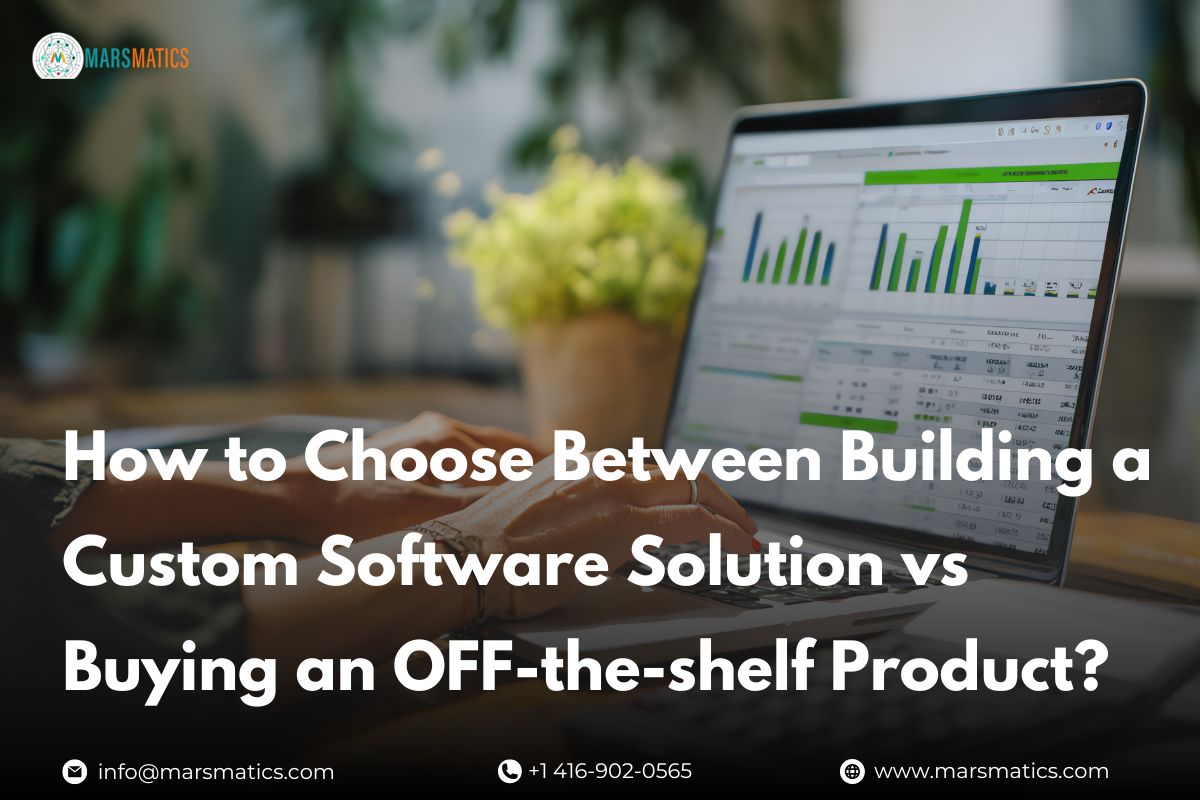How to Choose Between Building a Custom Software Solution vs Buying an OFF-the-shelf Product?
Choosing between custom software and off-the-shelf tools is one of the biggest technology decisions a business will make. The right choice impacts your budget, scalability, team productivity, and long-term growth. In simple words:
Off-the-shelf is fast and affordable. Custom software is flexible and future-proof.
But the best option depends entirely on your business.
This guide breaks down both options in a clear, practical way—so you can confidently decide what’s right for your organization.
What’s the Difference Between Custom Software & Off-the-Shelf Products?
What Is Custom Software?
Custom software is designed specifically for your business, built from scratch to match your workflows, processes, and long-term goals.
You control the features, user experience, integrations, and security standards. Companies usually choose custom software when their needs are unique or when they want to build something that gives them a competitive advantage.
What Is an Off-the-Shelf Software Product?
Off-the-shelf software is a ready-made, pre-built tool that you can start using immediately. It’s designed for the general market and offers a wide range of features that fit standard business needs.
Examples include CRM systems like HubSpot, project management tools like Trello, or accounting software like QuickBooks.
Quick Snapshot: When Each Makes Sense:
- Choose custom software when you need flexibility, scalability, and long-term control.
- Choose off-the-shelf when you need a quick, affordable solution with standard functionality.
Benefits of Custom Software Development:
Designed for Your Exact Business Needs:
Every organization has its own processes. Custom software ensures your workflow is never limited by the tool you use.
Instead of adjusting how your team works, the software adapts to them.
Scalable as Your Business Grows:
One major advantage of custom software is scalability.
Whether you add new departments, expand to new markets, or integrate new technologies—your solution can grow with you.
This makes custom software a smart long-term investment for fast-growing businesses.
Stronger Security & Data Ownership:
With rising cyber threats, businesses in healthcare, finance, and government often prefer custom-built systems because they provide:
- Private hosting
- Advanced security layers
- Full data ownership
- Industry-specific compliance
No shared infrastructure. No risky third-party dependencies.
Seamless Integrations:
From CRMs to ERPs to custom dashboards—custom software integrates effortlessly with your entire digital ecosystem.
Unlike off-the-shelf tools, you’re not limited by what the vendor allows.
Competitive Advantage:
When you build your own solution, you’re no longer using the same tools that thousands of competitors already use. You create a unique product that can improve performance, customer experience, and business efficiency in ways off-the-shelf systems can’t.
Benefits of Off-the-Shelf Software:
Lower Upfront Cost:
Off-the-shelf tools usually cost less initially because there’s no development phase. You pay a subscription or a one-time license fee and start using it immediately.
Also Read: Cost of Application Software for Startups
Instant Deployment:
No waiting months for development—just purchase, log in, and start working. This is ideal for startups or companies that need a quick fix.
Vendor Support & Regular Updates:
The software provider handles:
- Bug fixes
- Feature updates
- Security patches
- Technical support
Great for businesses without a dedicated IT team.
Tested Functionality:
Since thousands of users rely on the same product, most features are refined and thoroughly tested.
Downsides & Limitations of Each Approach:
Limitations of Custom Software:
- Requires higher upfront investment
- Development takes longer (weeks to months)
- Needs ongoing maintenance (although this often pays off long-term)
Limitations of Off-the-Shelf Software:
- Feature limitations: You can only use what the vendor gives you
- Scalability issues: May not support advanced or unique workflows
- Recurring subscription fees: Cost increases as your team grows
- Integration gaps: Doesn’t always connect well with your systems
- Vendor lock-in: Your data and features are tied to one company
These off the shelf software limitations often become major roadblocks as a business grows.
Cost Comparison: Custom vs Off-the-Shelf:
Upfront Cost vs Total Cost of Ownership (TCO):
Off-the-shelf is cheaper upfront.
Custom software is more expensive initially.
But long term?
Custom software often wins in ROI because you avoid per-user pricing, renewal fees, and integration add-ons.
Hidden Costs of Off-the-Shelf Tools:
Most businesses underestimate:
- Per-user fees
- Add-ons and API extensions
- Integration costs
- Migration costs
- Paying for unused features
Why Custom Builds Can Have Higher ROI:
With custom software:
- You pay once for development
- You own the code
- You add features only when needed
- You avoid long-term subscriptions
This makes custom solutions more cost-effective over the years.
Key Factors to Consider Before Making a Decision
Budget:
If cost is the immediate priority → off-the-shelf.
If long-term ROI matters → custom.
Timeline:
Need a system today? → off-the-shelf.
Can invest 3–6 months to build something powerful? → custom.
Workflow Uniqueness:
If your operations are unique or highly specialized, custom software is the right investment.
Scalability Requirements:
Companies planning rapid growth benefit more from scalable custom software.
Integration Needs:
If your systems must communicate seamlessly, custom is the safer choice.
Compliance & Security:
For healthcare, finance, insurance, and education—custom solutions provide better protection.
Data Ownership:
If you want full control and want to avoid vendor lock-in, custom software is the clear winner.
Also Read: White Label vs. Custom Mobile Apps
Real-World Examples: When Each Option Works Best
When Custom Software Is Best?
- Healthcare clinics needing secure patient management systems
- Finance teams needing automated compliance workflows
- E-commerce companies needing unique inventory management
- Growing startups building an MVP to scale later
- Enterprises replacing outdated legacy systems
When Off-the-Shelf Is Best
- Simple accounting
- Basic CRM needs
- Project management
- Email marketing
- Small teams with standard processes
Custom vs Off-the-Shelf Software: Quick Comparison Table
| Feature | Custom Software | Off-the-Shelf Software |
| Cost | Higher upfront | Lower upfront, ongoing fees |
| Deployment | Months | Instant |
| Scalability | High | Limited |
| Integrations | Unlimited | Restricted |
| Security | Strong, private | Vendor-controlled |
| Ownership | You own everything | Vendor-owned |
How to Decide: A Simple Framework for Businesses
Step 1: List Your Requirements:
What exactly do you need now and in the next 12–24 months?
Step 2: Check Your Workflow Complexity:
If it’s unique, custom is worth it.
Step 3: Compare Budget vs Long-Term ROI:
Initial cost should not overshadow long-term value.
Step 4: Evaluate Scalability Needs:
Is your business likely to outgrow off-the-shelf tools?
Step 5: Consider Security & Compliance:
Industries dealing with sensitive data should strongly consider custom development.
Step 6: Talk to a Software Expert:
A professional team can analyze your business and recommend the best model.
Why Choose Marsmatics for Custom Software Development?
At Marsmatics, we help businesses make the right technology decisions—not just build products.
Our team specializes in:
- Custom software development
- AI-powered applications
- Web and mobile app development
- Cloud-based scalable solutions
- Secure systems for healthcare, finance, retail, and real estate
Whether you want to build a custom solution or explore a hybrid model, we guide you through every step—from strategy to deployment.
Ready to find the right software path for your business?
Contact Marsmatics for a free consultation.
FAQs
Is custom software always better than off-the-shelf?
Not always. Custom software is better for companies with unique workflows, integration needs, or long-term growth plans. Off-the-shelf is great for standard, simple needs.
How long does it take to develop custom software?
Usually 3–6 months for an MVP and 6–12 months for a full enterprise solution. It depends on complexity.
How do I know if off-the-shelf software will limit my business?
If you’re constantly hitting feature limits, struggling with integrations, or paying for too many add-ons—it’s a sign the system no longer fits.
Which option has better long-term ROI?
Custom software often wins long-term due to scalability, no per-user pricing, and the ability to evolve with your business.








